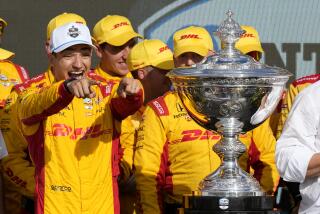Drivers Come and Go, but It’s Still Indy
- Share via
INDIANAPOLIS — Wait a minute! Someone’s trying to pull a fast one here!
I mean, what do they think--I just climbed down from a truckload of pumpkins?
Look, I know the Indianapolis 500. Lord knows I’ve seen enough of ‘em. This isn’t even a reasonable facsimile.
For instance, look around you. Where’s the Penske pit? Where’s the Gray Eagle of the Speedway, Roger himself, standing there with watches hanging off him and people all around him, tires in hand, waiting to spring into action? You can’t win a 500 till you’ve defeated a Penske car.
What’s going on? Isn’t there anybody named Andretti in here? How can you have an Indy 500 without somebody named Andretti in it? There’s been one here since 1965.
Well, at least, there’s an Unser in the grid. But wait a minute! It’s not Little Al, Big Al, Bobby. What’s Victory Lane without an Unser in it? Check it, nine times there’s been an Unser sipping milk on the checkered carpet of Victory Lane. Generations of Unsers. Little Al barely beat his father, Big Al, in the closest finish in Indy history in 1992. Little Al nipped Scott Goodyear by 0.0043 seconds and beat Dad, who was third by another click of the clock.
Now, that, sports fans, is Indy racing.
They call this place, affectionately, The Brickyard. There are bricks under that asphalt. And there’s a broken heart or a broken dream for every brick that’s there.
This is America’s Race. This is the four-wheeled Kentucky Derby, the automotive World Series, the heavyweight title fight, a motorized Super Bowl. As American as a harvest moon. As exciting as a goal-line stand. Which it often is. The apotheosis of America’s long love affair with the automobile. Wherever you go in the world, all you have to say is “Indy” and every child knows what you are talking about.
Its lore is deep in the fabric of the country. This place has a pact with its past. And an obligation to its future. Originally conceived as a testing ground for the newfangled horseless carriage, it has become a signal part of the bread-and-circuses America. An ode to speed.
Some scoff. They say it’s a contest of machines, not men. Don’t you believe it. These are athletes in these cars. If you don’t think so, try cornering an engine that is coming off a 260-mph straightaway in traffic going as fast as you are. Hitting a curveball, returning a serve, taking a jump shot takes athleticism. But so does trying to stay alive in a machine that’s trying to fly and only reluctantly stays on the ground moving faster than you can think. Confronting you with split-second decisions that make timing a fastball seem leisurely.
Catching a fly ball or nestling a long pass, netting a goal can be child’s play. For one thing, your life isn’t at stake there. You don’t get three strikes in a race car. It’s always fourth down. There really is no tomorrow in this World Series, quite literally.
You have to have the hand-eye coordination of a Michael Jordan, all right. The stakes are higher than money.
You used to have to pay your dues to get here. Now, you get in on a pass. Seventeen rookies got in the field this year. Rookies have always made Indy shudder. The last year that many rookies started, Herbert Hoover was president. Rookies tend to try to win the race in the first lap. Sometimes, they almost end it there.
It’s awash with history. The great Unsers raced here. Died here. Eddie Sachs loved this place. He drove fast, lived for Indy. He cried all the way around the parade lap when they sang “Back Home Again in Indiana” and the balloons soared skyward. The taps they played proved to be for him in 1964.
You weren’t sure Eddie wanted to win it. His life story would be over. He stopped in the pit one year with a comfortable lead in a last lap and changed a tire that may or may not have needed it.
The Offenhausers wound up on the backstretch here. The Novis screamed in the afternoon air like banshees. The sound and sight of Indy makes the pulse race.
The elegant Brits came with their motors in the back and taught the Yanks a lesson.
There’s a story in every tailpipe. You look out on the track and see where Danny Sullivan made his historic spin the year he won. Without superhuman agility on the part of Mario Andretti behind him, there would be two more black wreaths on Indy’s walls this day.
You look at the pit wall where Lloyd Ruby’s crew failed to get the fuel hose out of the tank in time. Gave an ironic twist to the adage that you win or lose an Indy in the pits.
You remember the year they left Mark Donohue’s crashed car inexplicably on the track at Turn 4 and Mike Mosley’s car crashed into it 100 laps later. Indy does things like that too.
It’s still Indy. There are floral wreaths piled on the door of garage No. 16 in Gasoline Alley where Scott Brayton went to join the 38 other racers who hit their last wall here.
Is this Indy’s Last Hurrah? Does it fade from the language--die, so to speak, in the pits?
Not the way to bet. Drivers are mortal, Indy eternal. The cars this year are the same. Only the chauffeurs are different. To sentimentalists, it’s a desecration. To a Tony George, it’s a consecration. To the public, it’s an auto race. If you don’t win here, you’re just a teamster.
More to Read
Go beyond the scoreboard
Get the latest on L.A.'s teams in the daily Sports Report newsletter.
You may occasionally receive promotional content from the Los Angeles Times.










